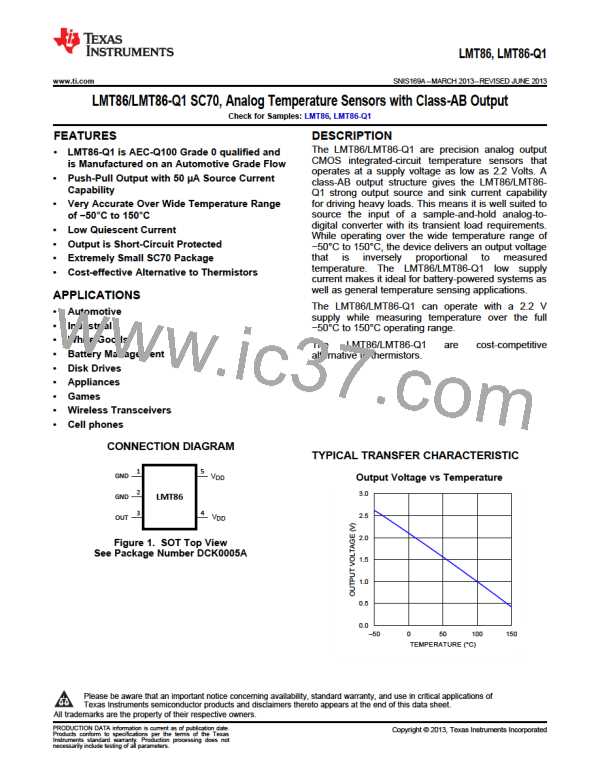LMT86, LMT86-Q1
SNIS169A –MARCH 2013–REVISED JUNE 2013
www.ti.com
Although the LMT86/LMT86-Q1 is very linear, its response does have a slight umbrella parabolic shape. This
shape is very accurately reflected in . The Transfer Table can be calculated by using the parabolic equation.
mV
°C
mV
°C2
»
ÿ
2 ÿ
»
VTEMP mV = 1777.3mV - 10.888
T - 30°C - 0.00347
T - 30°C
(
)
(
)
(
)
…
Ÿ
Ÿ
…
⁄
⁄
(1)
For a linear approximation, a line can easily be calculated over the desired temperature range from the Table
using the two-point equation:
V2 - V1
’
◊
’
ì
V - V1 =
(T - T1)
T2 - T1
(2)
Where V is in mV, T is in °C, T1 and V1 are the coordinates of the lowest temperature, T2 and V2 are the
coordinates of the highest temperature.
For example, if we want to resolve this equation, over a temperature range of 20°C to 50°C, we would proceed
as follows:
1558 mV - 1885 mV
o
’
’
ì
V - 1885 mV =
(T - 20 C)
50oC - 20oC
◊
(3)
(4)
(5)
o
o
ì
(-10.9 mV / C) (T - 20 C)
V - 1885 mV =
o
ì
(-10.9 mV / C) T + 2103 mV
V =
Using this method of linear approximation, the transfer function can be approximated for one or more
temperature ranges of interest.
MOUNTING AND THERMAL CONDUCTIVITY
The LMT86/LMT86-Q1 can be applied easily in the same way as other integrated-circuit temperature sensors. It
can be glued or cemented to a surface.
To ensure good thermal conductivity, the backside of the LMT86/LMT86-Q1 die is directly attached to the GND
pin (Pin 2). The temperatures of the lands and traces to the other leads of the LMT86/LMT86-Q1 will also affect
the temperature reading.
Alternatively, the LMT86/LMT86-Q1 can be mounted inside a sealed-end metal tube, and can then be dipped
into a bath or screwed into a threaded hole in a tank. As with any IC, the LMT86/LMT86-Q1 and accompanying
wiring and circuits must be kept insulated and dry, to avoid leakage and corrosion. This is especially true if the
circuit may operate at cold temperatures where condensation can occur. If moisture creates a short circuit from
the output to ground or VDD, the output from the LMT86/LMT86-Q1 will not be correct. Printed-circuit coatings are
often used to ensure that moisture cannot corrode the leads or circuit traces.
The thermal resistance junction to ambient (θJA) is the parameter used to calculate the rise of a device junction
temperature due to its power dissipation. The equation used to calculate the rise in the LMT86/LMT86-Q1 die
temperature is:
TJ = TA + qJA (VDDIS) + (VDD - VO) IL
»
ÿ
⁄
(6)
where TA is the ambient temperature, IS is the supply current, IL is the load current on the output, and VO is the
output voltage. For example, in an application where TA = 30°C, VDD = 5V, IS = 5.4 µA, VO = 1777 mV junction
temp 30.014°C self-heating error of 0.014°C. Since the LMT86/LMT86-Q1's junction temperature is the actual
temperature being measured, care should be taken to minimize the load current that the LMT86/LMT86-Q1 is
required to drive. Table 2 shows the thermal resistance of the LMT86/LMT86-Q1.
Table 2. LMT86/LMT86-Q1 Thermal Resistance
DEVICE NUMBER
TI PACKAGE NUMBER
THERMAL RESISTANCE (θJA)
LMT86DCK
DCK0005A
415°C/W
8
Submit Documentation Feedback
Copyright © 2013, Texas Instruments Incorporated
Product Folder Links: LMT86 LMT86-Q1

 TI [ TEXAS INSTRUMENTS ]
TI [ TEXAS INSTRUMENTS ]